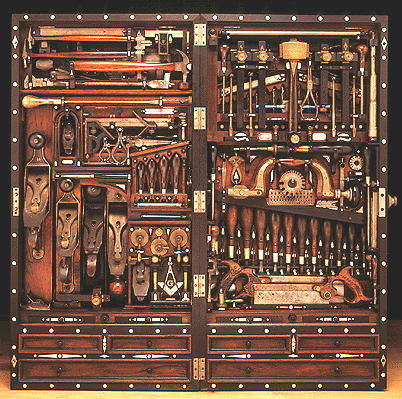Note that it might be unproductive to stay constrained within previous models and tools.
apply NoS to map problems<->algorithms and visualized on the side in real-time
HomePage
"Il ne nous reste exactement que l'inventivite.[...]
Aujourd'hui le travail intellectuel est oblige d'etre un travail intelligent
et non un travail repetitif comme il a ete jusqu'a maintenant."
from a generalized mess of tools  to ->
to ->
- automation(
- generative methods(
- phylogenization(
- inherence(
- dating(
- grammatization(

- +
 )
)
- + feedback of history of usage(
- individual
- + seed community of selected creators) ))
- ) then indexing() then categorizing() )))
- grammatization(
- dating(
- inherence(
- phylogenization(
- generative methods(
to finally propose routes through this newly created address space.
| Innovation chain phase | category* 1 | category ... | category x |
|---|---|---|---|
| early phase | function fe1 | function fe... | function fex |
| ... | function f... | function f... | function f... |
| generative GE/GA/... (a la backend | function f... | function f... | function f... |
| ... | function f... | function f... | function f... |
| middle phase | function fm1 | function f... | function fmx |
| ... | function f... | function f... | function f... |
| late phase | function fl1 | function f... | function flx |
CategoryLayer (reserved PmWiki name) (column) as layer- Phase (row)
- Strategy RequirementsSpecifying LegalFramework Knowledge! Financing Manufacturing Distribution Feasibility cf Seedea:Seedea/InnovationChain
- specific to the generation phase
- Strategy RequirementsSpecifying LegalFramework Knowledge! Financing Manufacturing Distribution Feasibility cf Seedea:Seedea/InnovationChain
- ExpressivePower!
- by default, cf Template
Note that all category names are unique thus forming a strict hierarchy, i.e. a category name in row can not exist in column.
Each column being a category as specified later on, aiding to pinpoint precisely the right function based on the specific project. Functions from other phases which seem disconnected or remote might still be efficient selectors (useful to reduce choices, even if costly). Overall the solution is a path amongst this matrices.
Solution Sx for user U based on requirements RU: fe1->f...->f...->f...->flx
The level of experience knowledge can also help to determine the tool (and the number of tools, e.g. a beginner could be satisfied with 4 pencils while somebody very used to it would benefit from a very large but still well organized palette) most adapted to a profile. Consequently, the criteria to select (or at least organize) tools should follow FB_Wiki:Events/PersonalUX#ToolSelectionProposal .
Previous successful projects, using this framework or not, can be use to try to provide better paths. Phylogeny are organized sets of previously tried solutions (successful or not).
Are Results? (or Designs? or Solutions?*) wiki history page enough to be conform and thus leverage ΦFP?
Profiles (representing actors as individual or entities) are linked to Results? by a producer link (could be in a Produced PTV list).
Instead of proposing the either the entire matrices or only path or paths, it could be possible to propose just a part of the matrices and it could be called a specialized "palette" (to follow the metaphor of the painter palette).
- addressing
- the final product (which is it Generated designs? Generators? *) could have a shorter direct URL
- e.g. Path:/ItemName rather than Path:/FinalProductGroupName/ItemName
- the final product (which is it Generated designs? Generators? *) could have a shorter direct URL
- demarcher des earlyvangelists/lead users/clients
- integrate http://www.innovativ.it/
- processing viz
dark skin- keep this for contacts/vulgarization
- link to http://lab.innovativ.it/
- do its todo list
- share back to Franck
- do its todo list
- add to the lab (with Cookbook:Import )
- decide a naming scheme (cf Addressing
) *
- Seedea:Seedea/InnovationChain
- apply R recommendation engine contest here, each component of the ideal innovation chain would then be recommended component by component
- it could also follow the suggestion proposed for iledeserte.net to make a list of Items? (or Functions to respect iconicity and not just enable Wikipedia:Genetic algorithmGA
but also Wikipedia:Grammatical evolutionGE
) with categories as "objective" items (via PmWiki:PageTextVariables and PmWiki:Categories) then for each add
- linked to usage properties
- e.g. used before other item I by person P for usage U at date D
- exploded items from sources (via Vi
and ?action=import in PmWiki
)
- Seedea:Seedea/BackEnd
- note that this remain the main focus and that other are optional but to guarantee precision or quality, to the produced result in a context, an environment (cf the poster and the red area focus)
- Seedea:Seedea/DATAmatrix
- Seedea:Seedea/AImatrix
- Seedea:Seedea/Alternatives
- Seedea:Seedea/Onlineoutsourcing
- Seedea:Seedea/Simulations
- visualization
- FB_Wiki:Tools/
- Seedea:Seedea/BackEnd
- FB_Wiki:OwnModelsApplied/LeveragingRandomness
- structure more {artificial,computational,automated,neurological}x{creativity,innovation,epistemology}
- results/designs/solutions
- decide a naming scheme (cf Addressing
- list usages using artificial creativity per domain
- applications then example and technical solutions + year (not the other way around)
- architecture http://projects.csail.mit.edu/emergentDesign/genr8/index.html year?
- Agency-GP AI Lab Website A Spatial Exploration Tool for Architects Based on Evolutionary and Agent Computation
- music http://www.csse.monash.edu.au/~cema/nodal/index.html year?
- industrial design GP by John R. Koza (e.g. antenna) year?
- software using genetic programming requirements year?
- ...
- move from a dated list to a phylogeny equivalent (cf ΦFP)
- see also
- to explore
- do not discard Seedea:Research/Research
- result being that tools listed before should be much more efficient using phylogenies as part of their input rather than starting out from nothing of from another structure (e.g. lists)
- https://secure.wikimedia.org/wikipedia/fr/wiki/Évolution_dirigée#Principales_soci.C3.A9t.C3.A9s
- visuals if required
- focus first on the smallest area possible
- that provide the best learning curve effect
- and the lower cost
- with reasonable competition
- see
- how to manage granularity?
- e.g. representing Wikipedia:Simple machine
as 1,2*3 or 6 functions?
- e.g. color and as light spectrum, notes as harmonics, periodic tables of elements as atomic numbers, etc
- initially restrict to FB_Wiki:Analysis/ExtendedLayeredModel
current models with their locus of analysis?
- can learning from fractal and infinite precision help?
- e.g. representing Wikipedia:Simple machine
- Is Wikipedia:Test-driven development
(with its methods Wikipedia:B-Method
or Wikipedia:Z_notation
or RSpec) applied in design or problem solving in general? Can it be used in conjunction with GA/GE/... ?
- it be a way to efficiently constrain the result (thus path)?
- if no path is found via simple stats (a la rec. engine)
- switch to less obvious path (eq. to simulated annealing/L−R+ATL)
- does building phylogeny really worth the trouble to infer from it structuring rules or conjectures?
- the first one probably not but as it is set up and as building import filters for more topics, the cost could keep on decreasing
- theoretical sources
- Seedea:Research/Research#PapersToRead
- Seedea:Research/Bibliography
- FB_Wiki:ReadingNotes/ScanningNotes
- http://www.routledge.com/books/details/9780805811537/
- http://www.cs.ucl.ac.uk/staff/p.bentley/evdes.html
- http://creative.canberra.edu.au/mitchell/metacreation.html
- http://art-artificial-evolution.dei.uc.pt/abstracts.htm
- http://l3dswiki.cs.colorado.edu:3232/CreativeIT/
- http://www.creativityandcognition.com/content/view/70/140/
- AI EDAM Artificial Intelligence for Engineering Design, Analysis and Manufacturing
- Shopping for Products You Don't Know You Need, Microsoft Research February 2011
- Seedea:Research/Research#PapersToRead
- context free grammar generators
- http://www.ykombinator.com
- +french one
- MIT fake paper generator
- ...
- http://www.ykombinator.com
- list all repository of designs I can find (git or not, especially as it seems most are still using wikis) and order them by FB_Wiki:Analysis/ExtendedLayeredModel
(which here has the fundamental impact of improving efficiency since higher patterns most likely have to use lower patterns!)
- CERN EHL http://www.ohwr.org
- biobricks http://partsregistry.org
- sc-fi writting e.g. Doctorow http://craphound.com/?p=2171
- WEATHER LAMP, Samuel Javelle FB_Wiki:Events/RADArt6
- consider inferring not just the phylogeny but rather the generator that lead to
- (if its not include e.g. in gener8 or agency-gp as official generators)
- asked #blinkenshell, #hplusroadmap and #git, ask Audrey
Note on archtecture
Inspired by Adriana and Paola coming back from Zaha Hadid exhibit as the Institut du Monde Arabe in July 2011.
- What tools is she used, especially since she received a mathematical education?
Explorer the hypothesis that architecture is a field with specificities that would make it especially receptive to this type of evo* or artificial creativity techniques
- expensive projects
- insurance as it hosts humans
- a form of luxury
- sometimes public
- physical projects with computationally possible to explore simulations
- material resistance (portance, ...)
This raise the question of how applicable such techniques are to other field, especially as the complexity grow by going higher in ELM or the funding involved is lower.
- clarify objective
- list constraints
- list multiple choices possibilities
- tagged with {$:DD} giving *
- list design decisions
- justify and document the choice
validate with use cases
- Nicolas' paper plane
- ?
- skdb&co
